Home | Category: Basic Christian Beliefs / Christian Prayers and Rituals / Orthodox Christians
SACRED MYSTERIES (SACRAMENTS) OF ORTHODOX CHRISTIANITY
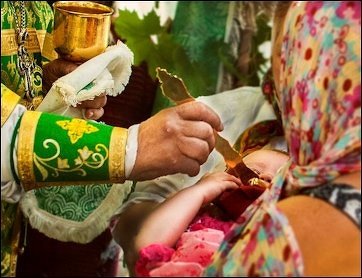
Russian Orthodox Sunday Communion
The most important Orthodox Christian Christian rituals are the seven scared mysteries (sacrament)s: 1) baptism; 2) Eucharist (communion); 3) confirmation; 4) penance and confession; 5) marriage; 6) unction (anointing the sick); and 7) holy orders (by which laymen are raised for the priesthood). These sacraments are still recognized by the Catholic Church (and mostly by the Orthodox church) but have been rejected, with the exception of baptism and communion, by the Protestant church. There are other sacraments in the Orthodox church but these are not regarded as important as the seven previously mentioned ones.
All the sacraments are carried out so they ascribe to the concept of an individual as being part of a community rather than something onto himself or herself. The church itself is regarded as a source of sanctification and blessing for all aspects of life
A great effort has been made to preserve the material elements of the sacraments. Orthodox Christians look down on attempts by the Catholic church to minimize the material side of the sacraments such as pouring water rather than using immersion in baptism and using unleavened rather than leavened bread in the Eucharist.
The process of ordination begins with a nomination by a local congregation and ends with the formal laying of hands by a bishop in the name of the Church Universal. In the ordination ceremony, a candidate is brought before the congregation assembled to authorize the ordination. After formal approval is granted by the laity, the bishop lays his hands on the candidate and invokes divine help. The united prayers of the whole church are necessary to fulfil this sacrament.
Marriage is regarded as a sacrament in the Orthodox church and called “the crowning.” During Orthodox weddings the bride and groom exchange “crowns of glory” instead of rings. In the ceremony neither the bride or the groom make any promises; they merely express their consent to marry one another.
Websites and Resources Orthodox Church in America oca.org/saints/lives ; Online Orthodox Catechism published by the Russian Orthodox Church orthodoxeurope.org ; Internet Sourcebook sourcebooks.fordham.edu ; BBC on Orthodox Christian bbc.co.uk/religion/religions/christianity ; Christian Answers christiananswers.net ; Christian Classics Ethereal Library www.ccel.org ; Sacred Texts website sacred-texts.com ; Christianity.com christianity.com/church/denominations ; Christianity Comparison Charts religionfacts.com ; Difference between Christian Denominations Quoracom
RECOMMENDED BOOKS:
“The Orthodox Church: An Introduction to Eastern Christianity” by Timothy Ware Amazon.com ;
“The Orthodox Study Bible, Hardcover: Ancient Christianity Speaks to Today's World
“by St. Athanasius Academy of Orthodox Theology Amazon.com ;
“Thinking Orthodox: Understanding and Acquiring the Orthodox Christian Mind”
by Eugenia Scarvelis Constantinou Ph.D. Amazon.com ;
“A Basic Guide to Eastern Orthodox Theology: Introducing Beliefs and Practices” Amazon.com ;
“Two Become One: An Orthodox Christian Guide to Engagement and Marriage”
by Antonios Kaldas and Ireni Attia Amazon.com ;
“Marriage: An Orthodox Perspective” by John Meyendorff Amazon.com
“On the Sacraments of the Christian Faith (De Sacramentis)
by Hugh of Saint-Victor Amazon.com ;
“Lectures on the Christian Sacraments” by St Cyril of Jerusalem Amazon.com ;
“Introduction to Christian Worship” by James F White Amazon.com ;
“The Oxford History of Christian Worship” by Geoffrey Wainwright and Karen B. Westerfield Tucker Amazon.com ;
“Ancient Christian Worship: Early Church Practices in Social, Historical, and Theological Perspective” by Andrew B. McGowan Amazon.com
Orthodox Christian Baptism and Chrismation
Baptism is an important ritual. The whole body is immersed in water that has been previously blessed by special prayers. Orthodox Christians dismiss the Catholic act of just pouring water on the person being baptized. Orthodox baptism represents the inclusion of a newly born Christian into the community of believers.
Chrismation—also known Confirmation or Christening—is also important to Orthodox Christians. Children are confirmed with a sacred oil that has been elaborately prepared in a ceremony presided over by a Patriarch. It represents the sacrament of the Pentecost— when a Christian receives the gift of the Holy Spirit, enabling him or her to receive all other sacraments and elevating them to a kind of “special order” status that allows them to teach, and take part in governing a Christian community.
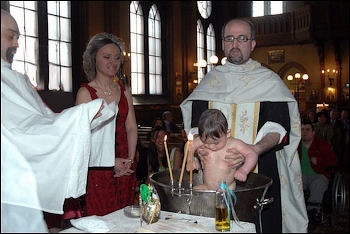
Greek Orthodox baptism
According to the BBC: The first two of seven principal Mysteries or sacraments at the heart of the Eastern Orthodox Church “are Baptism and Chrismation. Baptism of adults and infants is by immersion in water three times in the name of the Trinity and is both the initiation into the Church and a sign of forgiveness of sins. [Source: BBC, June 11, 2008 |::|]
“Chrismation follows immediately after baptism and is by anointing with holy oil called Chrism. Chrismation is followed by Holy Communion. This means that in the Orthodox Church babies and children are fully communicant members of the Church. Chrism can only be consecrated by the Patriarch, or chief Bishop, of the local Church. Some of the old Chrism is mixed with the new, thus linking the newly baptised to their forbears in the faith. |::|
The Chrism is used to anoint different parts of the body with a sign of the cross. The forehead, eyes, nostrils, mouth and ears, the chest, the hands and the feet are all anointed. The priest says the words, "The seal of the gift of the Holy Spirit" as he makes the sign of the cross at each point. |::|
“The newly baptised Christian is now a layperson, a full member of the people of God (the 'Royal Priesthood'). All Christians are called to be witnesses to the Truth. Chrismation is linked to Pentecost in that the same Holy Spirit which descended on the apostles descends on the newly baptised. |::|
Children are baptized and christened around the age of ten months or earlier to signify salvation. Orthodox Christianity differs from Western Christianity in that baptism and christening are performed together. Having these sacraments performed at such an early age means that life as a religious participant begins very early.
Orthodox Christian Confession
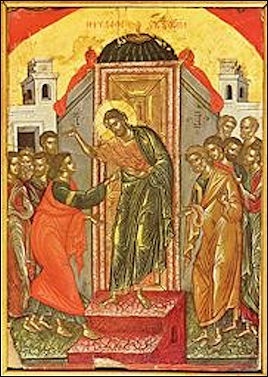
Orthodox icon of Saint Thomas's confession
Orthodox Christians receive their first confession at around age seven. The event is preceded with instruction about moral responsibility. Afterwards a young person is deemed old enough to fast, reflect on themselves morally and receive confession. In the Russian church the taking of Holy Communion is always preceded by confession. Among other Orthodox groups confessing is not so commonly used. Confession is not simple a confession before a priest after one has sinned. In accordance with Orthodox teachings, a sinner is expected to make amends with the people who have been harmed by his actions first . Only then does he go before priest to confess.
According to the BBC: “All Orthodox Churches use the Mystery of Penance, or Confession, but in Greek speaking Churches only priests who have been blessed by the Bishop as 'Spiritual Fathers' are allowed to hear confession. Children may be admitted to the sacrament of Confession as soon as they are old enough to know the difference between right and wrong. [Source: BBC, June 11, 2008 |::|]
“Through this sacrament sinners may receive forgiveness. They enter into confession with a priest often in an open area in the church (not in a confessional as in the Roman Catholic tradition nor separated by a grille). Both priest and penitent stand and a cross and book of the Gospels or an icon is placed in front of the penitent with the priest standing slightly apart. This stresses that the priest is simply a witness and that forgiveness comes from God not the priest. The priest will then hear the confession and perhaps give advice. After confession the penitent kneels before the priest, who places his stole on the penitent's head saying a prayer of absolution. |::|
In Catholic confession, the priest acts as a judge and decides what an individual can do to be absolved of his sin. An Orthodox priest by contrast acts as a witness not a judge. He gives an introductory prayer and tells the penitent that only Jesus Christ can heal him. The priest acts as a fellow member of the church and a shoulder to cry on so to speak and offers advise on how the penitent can repent. At the end of the confession the priest asks God to reconcile the penitent to the church and forgive him of his sins.
Eucharist in Orthodox Christianity
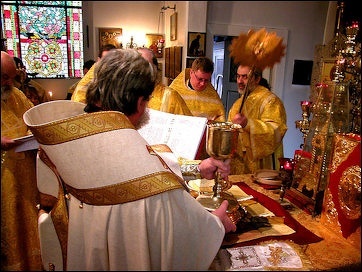
Orthodox eucharist (communion)
The religious scholar Nicolas Zernov wrote: “The Eucharist is seen by the Orthodox Christians as the revelation of the divine Presence in the material world. Their rite has no single culminating point, but represents a gradual unveiling of Christ’s mystical presidency over the assembly of the faithful” and that “man is a worthy recipient of sacred mysteries.” The Eucharist “is based on the idea that matter is spirit-bearing and it is not only the participants but also their bodies and the fruits of the Earth transformed into bread and wine by their labors, which are sanctified and brought into sacramental union with the risen Christ and his glory.”
By contrast, through consecration in the Catholic Eucharist, according to the doctrine of Transubstantiation, the materials of the bread and wine keep their appearance of bread and wine but change their material substance into the Body and Blood of Christ.
The Orthodox Eurachrist is treated as a feast of both soul and body. The communion table is called the “Throne.” The screen, whose doors are opened and closed at various points of the service, are vital for the presentation of the Eucharist. A recipient of the Orthodox Eucharist does kneel after he has consumed the bread and wine. Leavened bread and red wine mixed with hot water are used.
According to the BBC: “The Eucharist, usually called the Divine Liturgy, fulfils the command of Jesus Christ at the Last Supper: "Do this in remembrance of me". A member of the congregation standing at the front of the church to lead the hymn-singing As in many Western churches the Eucharist is a service consisting, in the first part, of hymns, prayers, and readings from the New Testament, and in the second the solemn offering and consecration of leavened bread and wine mixed with water, followed by the reception of Holy Communion. [Source: BBC, June 11, 2008 |::|]
“The Orthodox believe that by the consecration the bread and wine are truly changed into the Body and Blood of Christ. Communion is given in a spoon containing both the bread and the wine and is received standing. A sermon is usually preached either after the reading of the Gospel or at the end of the service. At the end of the Liturgy blessed, but not consecrated, bread is distributed to the congregation, and non-Orthodox are often invited to share in this as a gesture of fellowship." |::|
Anointing of the Sick
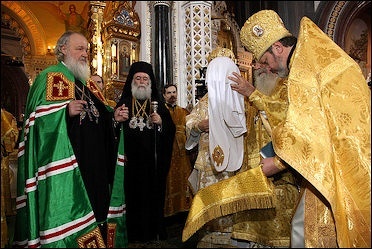
According to the BBC: ““In Greek-speaking Churches this is performed annually for the whole congregation during Holy Week on the eve of Holy Wednesday. Everyone is encouraged to come forward for anointing with the special oil whether they are physically ill or not. This is because it is generally held that all are in need of spiritual healing even if they are physically well. [Source: BBC, June 11, 2008 |::|]
“Anointing of the sick can also be performed on individuals. People sometimes keep the blessed oil of the sick in their homes. Timothy Ware said: “This sacrament,', remarks Sergius Bulgakov, 'has two faces: one turns towards healing, the other towards the liberation from illness by death.” [Source: Timothy Ware, The Orthodox Church] |::|
“The Church anoints the sick with oil, following the teaching of St James in his Epistle (5:14-15), "Is anyone among you sick? He should summon the presbyters of the Church, and they should pray over him and anoint (him) with oil in the name of the Lord, and the prayer of faith will save the sick person, and the Lord will raise him up. If he has committed any sins he will be forgiven."" |::|
Russian Marriage and Wedding
Marriage is regarded as a sacrament in the Orthodox church and called “the crowning.” During Orthodox weddings the bride and groom have traditionally exchanged “crowns of glory” instead of rings but these they often exchange rings too. In the ceremony neither the bride or the groom make any promises; they merely express their consent to marry one another. According to the BBC: “Marriage is celebrated through the rite of crowning, showing the importance of eternal union of the couple. Although marriage is seen as a permanent commitment in life and in death, remarriage and divorce are permitted in certain circumstances. [Source: BBC, June 11, 2008 |::|]

Orthodox wedding
Orthodox wedding ceremonies have traditionally been part of a full mass. The central elements of the ceremony are the presentation of rings and the exchanging of crowns. According to Russian Orthodox custom, married couples wear their wedding bands on their right hands.
During some Orthodox Christian ceremonies rings are given to the bride and groom by a priest. The couple approach a table at the altar. Incense smoke pours out of swinging sensors that are carried before them. The priest recites a litany, invokes a prayer and blesses the couples. He gives the bride and groom each a ring from the table and proclaims them "married now and forever" three times as the couple exchange rings three times. Sometimes the couples’ hands are bound together with a long embroidered scarf called a "rushnychok".
The priest takes the rings and makes a cross on the foreheads of the bride and groom. The rings are then placed on their right hands and the priest recites passages from the Bible and declares that the ring is a symbol of "union, honor and power.”
Orthodox Christian Funerals
Burial in a consecrated ground has traditionally been important to Orthodox Christians. Cremation has traditionally been forbidden by the Orthodox Church, which sees the human body as a temple for the soul and burying intact ensures that a person is in one piece when the resurrection comes. Any meddling with the body is regarded as a desecration and an offence against god.
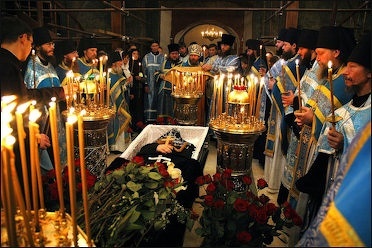
Orthodox funeral service
In Orthodox countries like Romania and Bulgaria, cremation became legal under Communist rule. Orthodox funeral rites are held over he ashes of cremated bodies. Only Greece and Cyprus still forbid it.
A memorial service 40 days after a death is very important in the Orthodox religion. In Byzantine tombs, the head of the dead was propped up facing east. Byzantines burned lamps at grave sites.
Death is viewed not as the destruction of matter and the body but rather as transformation into matter that is obedient to the Holy Spirit. The dead are still regarded as part of the congregation. Remembering departed loved ones is an important aspect of Orthodox prayer life. Prayers are said to the dead and requests are made for them with the belief that the power of love is stronger than the power of death. Orthodox Christians do not define the status of the dead and do not claim to know what effect their prayers might have on them.
Image Sources: Wikimedia Commons
Text Sources: Internet Sourcebook sourcebooks.fordham.edu ; “World Religions” edited by Geoffrey Parrinder (Facts on File); “ Encyclopedia of the World’s Religions” edited by R.C. Zaehner (Barnes & Noble Books, 1959); King James Version of the Bible, gutenberg.org; New International Version (NIV) of The Bible, biblegateway.com; Christian Classics Ethereal Library (CCEL) ccel.org , Frontline, PBS, Wikipedia, BBC, National Geographic, New York Times, Washington Post, Los Angeles Times, Smithsonian magazine, The New Yorker, Time, Encyclopedia.com, Reuters, Associated Press, Business Insider, AFP, Library of Congress, Lonely Planet Guides, Compton’s Encyclopedia and various books and other publications.
Last updated March 2024
